The Environment
Emissions
KPI
Responsible Departments
Stance and Target
Review of FY 2021 Activities
Introduction of Initiatives
Issues and Future Improvement Measures
KPI
Move the screen to the left or right to see the table information
| Item | FY 2020 results | FY 2021 results |
|---|---|---|
| Emissions of greenhouse gases |
(連結) Scope1 535 thousand tons Scope2 451 thousand tons Scope3 22,580 thousand tons |
(連結) Scope1 613 thousand tons Scope2 486 thousand tons Scope3 25,701 thousand tons |
| Ozone-depleting substances | Emissions of CFCs (Domestic) 309.5 tons |
Emissions of CFCs (Non-consolidated) 617.8 tons |
| HAPs (Hazardous Air Pollutants) | (Domestic) 17.3 tons | (Domestic) 12.3 tons |
Responsible Departments
Each business location
- Activities are conducted by each location, and the direction of policies and activity measures are decided on by bodies that include the Global Warming Countermeasures Committee and the Chemical Substance Management Committee.
- In 2022, the Global Warming Countermeasures Committee has been reorganized into the Carbon Neutral Committee.
Stance and Target
Why is “Emissions” a critical issue to be addressed?
Explanation of the reason and background
We use resources to manufacture and sell various rubber products such as tires, hoses, and belts. In addition, we handle chemicals adhesives and sealants. In particular, we recognize the reduction of emissions in the manufacturing process and the use of products as an important initiative that will lead to the prevention of global warming and environmental pollution, as well as sustainable operations at each business location.
Policies and stance relating to air pollution
The Yokohama Rubber Group will work to minimize the burden on the environment caused by the provision of products and services in accordance with the Yokohama Rubber Environmental Policy, and Yokohama Rubber Group Action Guidelines.
To this end, we will develop and introduce environmental technologies while working together with various people involved in the provision of products and services to reduce air pollution throughout the entire value chain.
We comply with international agreements on emission, the regulations of each country (in Japan, the Energy Saving Act, Act on Promotion of Global Warming Countermeasures, etc.), and the regulatory response policy of related organizations such as the Japan Rubber Manufacturers Association while setting stricter self-imposed standards in order to control air pollution.
To this end, we will develop and introduce environmental technologies while working together with various people involved in the provision of products and services to reduce air pollution throughout the entire value chain.
We comply with international agreements on emission, the regulations of each country (in Japan, the Energy Saving Act, Act on Promotion of Global Warming Countermeasures, etc.), and the regulatory response policy of related organizations such as the Japan Rubber Manufacturers Association while setting stricter self-imposed standards in order to control air pollution.
Risks and opportunities at the Yokohama Rubber Group related to greenhouse gas emissions
<Risks>
Risks include an increase in facility investment costs incurred in order to reduce emissions, an increase in energy costs related to the use of renewable energy, and global warming leading to deterioration in the working environment and an increase in investment costs for countermeasures.
<Opportunities>
We contribute to society by improving the energy efficiency of operations through the reduction of emissions, environmental conservation in the areas we operate in, and the external provision of heat insulation materials, etc. Because controlling emissions of volatile organic compounds (VOC) and air pollutants in addition to greenhouse gas emissions makes it possible to reduce the cost of environment-related investment, this leads to a reduction in product manufacturing costs.
Use of offsets
Offsets are not used.
Vision (attainment goal) / target
As international regulations related to emissions become increasingly stringent, as a general rule we aim to achieve control standards equivalent to those of the developed economies.
The Yokohama Group is working to reduce total greenhouse gas (GHG) emissions as an energy use reduction target.
The Yokohama Group is working to reduce total greenhouse gas (GHG) emissions as an energy use reduction target.
- Long-term target:
- Achieve net zero CO2 emissions (carbon neutrality) in our activities by 2050
- Mid-term target:
- Reduce CO2 emissions from company activities by 38% by 2030 compared to fiscal 2013
*This activity is on the same level as our goal of a 28% reduction by 2030 (compared to 2019). - Encourage suppliers to collaborate with us in meeting our targets.
- Reduce CO2 emissions from company activities by 38% by 2030 compared to fiscal 2013
Measures for vision achievement
The Group conducts the following measures to monitor and reduce the environmental footprint that is produced through our production activities, R&D, and offices.
- The Group sets independent management standards that are stricter than those required in accordance with laws and regulations, and based upon which we conduct constant monitoring.
- Legally-required measurement results are regularly reported to government authorities and local residents.
- We will strengthen activities aimed at reducing our environmental burden, such as improvements to our production process.
Conversion of energy used, introduction of renewable energy, control of waste heat through heat retention and insulation, and the introduction of the latest environmental technologies and systems. - Prevention of environmental pollution
Identification and remedying of environmental pollution risks, conducting regular monitoring and measurements, etc. - Chemical substance management
We confirm the suitability of chemical substances to be used in our products at the time of adoption or changes in laws and regulations.
We minimize environmentally hazardous substances in our business activities and products, and reduce emissions of VOCs and hazardous substances.
Review of FY 2021 Activities
There were no events that led air pollution.
We carefully manage the concentration of our NOx and SOx emissions to fully comply with parameters specified by law.
We carefully manage the concentration of our NOx and SOx emissions to fully comply with parameters specified by law.
Emissions of NOx, SOx, etc.
(Domestic) (Unit: tons)
| Cat | NOx | SOx |
|---|---|---|
| FY 2020 | 115.1 | 2.3 |
| FY 2021 | 111.8 | 3.3 |
We do not use or emit any ozone-depleting substances. There were no cases of dioxin use.
GHG emissions for Scope 1+2 increased 5.0% from the previous year in Japan, partly due to the expansion of the scope of calculation and an increase in production volume.
Overseas, on the other hand, emissions increased 13.9% from the previous year due to the expansion of the scope of calculation, factory expansions, and increased production, resulting in an overall increase of 11.5%.
The overall VOC emissions increased by 21.0% from the previous year.
GHG emissions for Scope 1+2 increased 5.0% from the previous year in Japan, partly due to the expansion of the scope of calculation and an increase in production volume.
Overseas, on the other hand, emissions increased 13.9% from the previous year due to the expansion of the scope of calculation, factory expansions, and increased production, resulting in an overall increase of 11.5%.
The overall VOC emissions increased by 21.0% from the previous year.
Greenhouse gas emissions at domestic group companies and overseas production bases (thousand t-CO2)
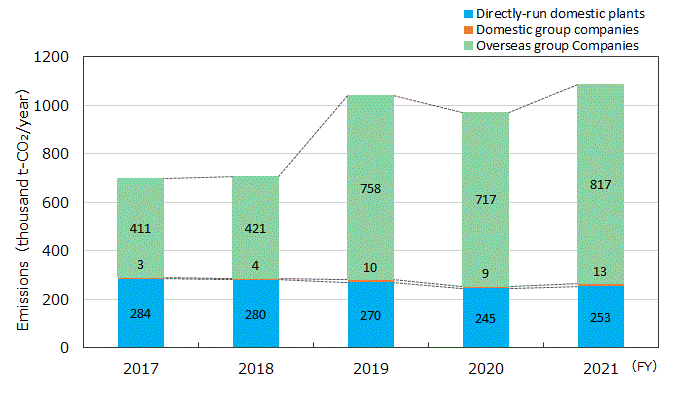
Scope 3 estimation
The results for Scope 1 to 3 emissions for fiscal 2021 are as follows. A breakdown of Scope 3 is also displayed.
Greenhouse gas emissions (Scope 1+2) resulting from the corporate activities of Yokohama Rubber during fiscal 2021 were 1,099 thousand t-CO2, and greenhouse gas emissions including indirect ones (Scope 3) for the entire value chain were 25,701 thousand t- CO2. This is due to the expansion of the scope of calculation.
Scope 3 accounted for 95.8% of this, and use of products accounted for 74.3% of Scope 3 emissions. We will work towards the spread of environmentally friendly products and fuel efficient tires while working together with suppliers to reduce GHG emissions throughout the value chain.
Greenhouse gas emissions (Scope 1+2) resulting from the corporate activities of Yokohama Rubber during fiscal 2021 were 1,099 thousand t-CO2, and greenhouse gas emissions including indirect ones (Scope 3) for the entire value chain were 25,701 thousand t- CO2. This is due to the expansion of the scope of calculation.
Scope 3 accounted for 95.8% of this, and use of products accounted for 74.3% of Scope 3 emissions. We will work towards the spread of environmentally friendly products and fuel efficient tires while working together with suppliers to reduce GHG emissions throughout the value chain.
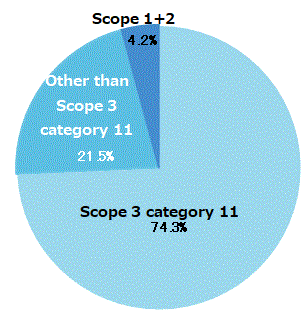
Move the screen to the left or right to see the table information
| Cat | Scope 3 category | Emissions (thousand t-CO2) |
|---|---|---|
| 1 | Purchased products and services | 4,031 |
| 2 | Capital goods | 152 |
| 3 | Fuel and energy | 147 |
| 4 | Transportation and distribution (upstream) | 154 |
| 5 | Waste | 50 |
| 6 | Business travel | 5 |
| 7 | Commuting employees | 21 |
| 8 | Upstream lease assets | NA |
| 9 | Downstream transportation and distribution | 72 |
| 10 | Processing of sold products | 10 |
| 11 | Use of products | 19,940 |
| 12 | Disposal of products | 875 |
| 13 | Downstream lease assets | NA |
| 14 | Franchise | NA |
| 15 | Investment | 246 |
| 25,701 |
- 1 Scope 1: Direct emissions of greenhouse gases by the company (examples: fossil fuel, natural gas, etc.)
- 2 Scope 2: Indirect emissions of greenhouse gases by the company (electric power use, etc.)
- 3 Scope 3: Greenhouse gases emitted indirectly by the Company through the supply chain (examples: manufacturing, transportation, business travel, commuting, etc.)
- 4 The calculation was conducted in accordance with the criteria of Scope 3 issued by the GHG PROTOCOL.
Verification of greenhouse gas (GHG) emissions
Verification by a third party was obtained in order to verify the reliability of GHG emission calculation information.
- Third-party greenhouse gas verification report
Introduction of Initiatives
Conversion to the use of natural gas as fuel
The use of natural gas through environmentally friendly gas supply line is continuously being implemented in factories in Japan. Efforts to switch to natural gas as a source of fuel in reducing CO2 emissions are also implemented in overseas factories where gas supply lines are not yet in place. This includes using tank lorries to transport liquefied natural gas in the Vietnam Plant and use of gas cylinders in the India Plant to replace heavy fuel oil.
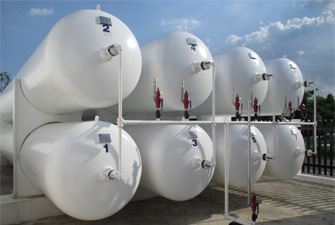
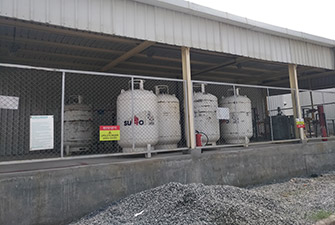
Switch to gas cylinders in the India Plant
Installation of solar lights
Installation of outdoor lights using a combination of high efficiency solar panel and LED
The outdoor lights will be effective even in events of a disaster or power outage due to their independent power supply.
The outdoor lights will be effective even in events of a disaster or power outage due to their independent power supply.
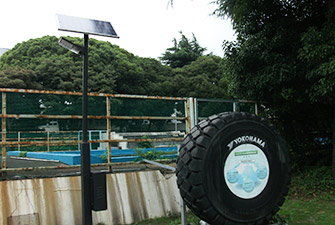
Installation of solar street lights
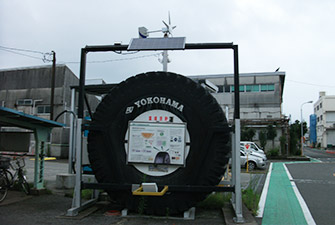
Installation of solar and wind powered street lights
Utilizing heat recovery technology to use factories’ waste heat for air-conditioning (absorption chilling equipment)
By adopting absorption chilling equipment, which uses heat recovery from waste heat etc., we are able to reduce CO2 emissions and also reduce peak electric power consumption during the summer months.
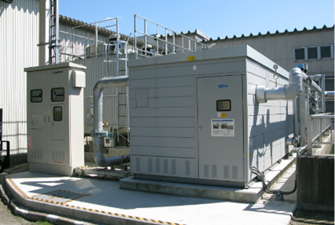
Absorption chilling equipment
Steam driven compressor
The plant gets air from air compressor powered by the energy harvested from the pressure difference as steam decompresses, which has never been used before.
Showing results in cutting down power consumption and CO2 emission.
Showing results in cutting down power consumption and CO2 emission.
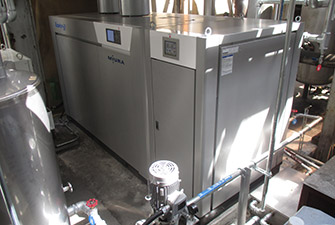
Steam driven compressor
Energy saving improvements through heat insulation materials
We manufacture and install heat insulation materials fitting the size of equipment and piping.
We are implementing energy-saving activities that control heat release by installing heat insulation materials on and near steam pipework in our business locations both in Japan and overseas.
We are implementing energy-saving activities that control heat release by installing heat insulation materials on and near steam pipework in our business locations both in Japan and overseas.
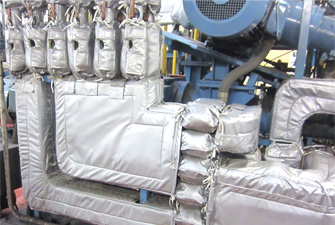
Pipe insulation
Energy-Saving Technology Committee
The Energy-Saving Technology Committee helps to improve the effectiveness of measures to reduce energy consumption through the adoption of energy management methods conforming to the Act on the Rational Use of Energy, the introduction of energy-saving equipment, etc.
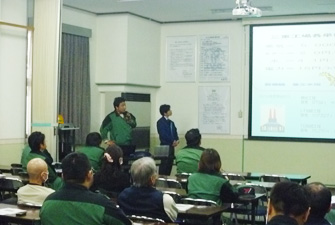
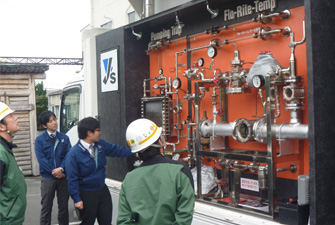
Energy-Saving Technology Committee
As well, energy saving activities are implemented from the management level as well.
- Promoting the office black illumination, leaving work on time campaign
- Energy saving programs in summer (cool biz) and winter (warm biz)
- Thoroughly enforce turning off standing by power consumption of OA equipment
- Enhance energy saving awareness by making the energy consumption rate visible
- Develop a lateral spread of energy saving improvements by sharing case examples (database building)
Issues and Future
Improvement Measures
Issues include thorough management of data on global air emission volumes at overseas sales bases, etc. and working to reduce emissions in collaboration with the supply chain.


